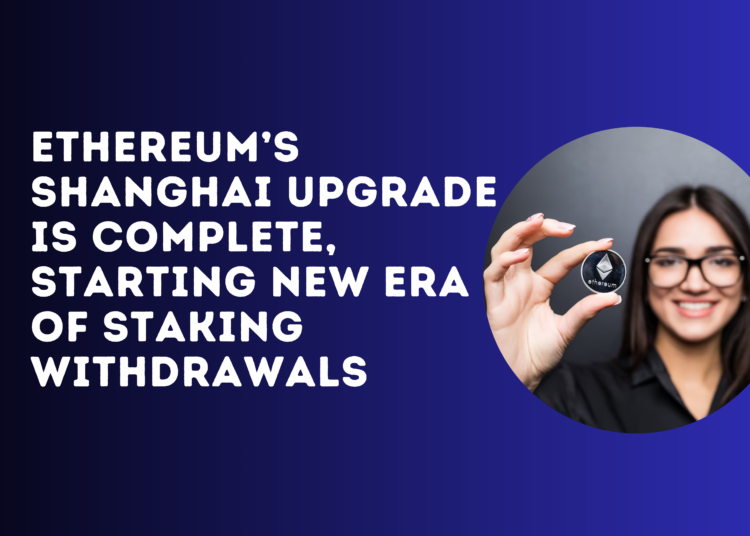Ethereum’s Shanghai Upgrade Is Complete, Starting New Era of Staking Withdrawals
The Shanghai hard fork of Ethereum, also known as “Shapella,” has been completed, allowing withdrawals for users who have “staked” their ether (ETH) to protect and confirm transactions on the blockchain.
22:27 UTC saw the start of the Shanghai upgrade, and 22:42 UTC saw its completion.
As of epoch 194,408, 285 withdrawals totaling 5,413 ETH ($10 million) had been processed, according to beaconcha.in, around 30 minutes after the Shanghai upgrade had been turned on.
Members of the Ethereum community have described the much-anticipated hard fork, which effectively upgraded the blockchain by splitting off a new one, as a historic milestone that brought an end to the multi-year transition to a full proof-of-stake network.
Users “stake” money in a proof-of-stake mechanism to help secure and confirm fresh data blocks. Since the blockchain’s old proof-of-work consensus process, used by Bitcoin, was abandoned last year, users have been unable to withdraw staked ether or cash out accrued prizes, which is a key component of the new paradigm.
When the Shanghai hard fork was initiated, the price of ETH was largely flat, and roughly 4000 people watched an Ethereum Cat Herders-hosted Shapella Mainnet Watch Party.
The co-founder of the Ethereum blockchain, Vitalik Buterin, stated during the livestream that “we are in a stage where the hardest and fastest aspects of the Ethereum protocol’s transition are practically completed. Although there are still important tasks to complete, they can be completed safely at a slower pace.
After Shanghai, scaling—making transactions quicker and less expensive—will be the issue that the blockchain addresses, according to Buterin. “We know consumers will be forced to pay $500 transactions if we don’t improve scaling before the next bull run. However, even while things might be bad if Verkle Trees aren’t in place before the next bull run, it’s still a lot less of an issue than, say, $500 transactions, right?
Analysts of the digital asset market have debated for months whether the Shanghai hard fork would serve as a catalyst for a price increase or decline: Will its performance improve market sentiment, or will investors rush to sell their shares after big ETH redemptions?
Validators and staking
When Ethereum underwent the “Merge,” a hard fork that replaced its outdated proof-of-work (PoW) consensus method with proof-of-stake (PoS), the project established a new breed of “validators” to maintain the blockchain. Although the PoS consensus mechanism cut Ethereum’s energy use by 99%, its creators also anticipated that the network would be safer and more decentralised under PoS.
Ben Edgington, product lead for Teku, a ConsenSys client for Ethereum, said, “It’s always been our goal that Ethereum is something that is an army of tens of hundreds of solo node operators, not you know, three or four large pieces of data.” (A blockchain client is a piece of software.) I think we have created a technique that makes it possible, which is a significant improvement over PoW.
In a blog post from November 2020, Vitalik Buterin predicted that PoS would result in “higher wealth concentration over the long term.” This is due to the fact that under PoS, all you need to stake is ether, and you can earn additional ether by staking. In PoW, you can still earn ether, but only with the help of outside resources. Therefore, Buterin claimed that over time, PoS “coin distributions risk becoming more and more concentrated.”
Validators must “stake” at least 32 ETH by sending them to a smart contract where the money is locked in order to take part in the block validation process and protect the Ethereum network. A validator’s chances of proposing a “block” of data transactions to be confirmed on the blockchain increase with the amount of ETH they stake. A validator receives an additional payment when they suggest a block and the other validators accept it.
32 ETH was worth around $15,000 when the PoS chain initially went live. Since then, ETH has increased dramatically and is now worth roughly $58,000. One theory that some investors may decide to sell their ETH in order to book profits is based on price increases.
Not everyone has 32 ETH on hand to be able to stake them all at once. As a result, liquid staking providers emerged as a substitute, allowing users who wished to take part in the staking process to contribute any amount of ETH they desired, with the help of third-party providers who would stake that ETH and operate the validator on behalf of the group of customers.
About 23% of all ETH staked is under the hands of Lido, the largest liquid staking provider. Another 22% of staked ETH is under the ownership of Coinbase, Kraken, and Binance, three of the biggest cryptocurrency exchanges in the world.
The success of Ethereum and its creator, Vitalik Buterin, serves as a testament to the power of cryptocurrencies and their potential to transform the world of finance. Hire a cryptocurrency development company that has a team of skilled developers, designers, and project managers who work together to build and improve cryptocurrency platforms to make money with Crypto.
Shanghai: Unstaking now ready
Validators can unstake in a variety of ways, but the two most common ones are partial withdrawals and full withdrawals.
Partial withdrawals involve removing only the benefits gained through staking and leaving the initial amount of staked ether. Solo stakers who operated their own validators were required to switch to a 0x01 withdrawal certificate. Partial withdrawals cannot occur automatically without it.
Users were able to immediately enjoy their long-awaited prizes when the upgrade was activated (as the blocks didn’t need to finalise). However, Ethereum can only handle 16 requests for partial withdrawals in a single slot (12 seconds apart). The waiting period for withdrawals could go for hours, depending on how many requests there are.
As the initial few hundred validators are all 0x00, there most likely won’t be any partial withdrawals during the first few epochs, according to Barnabas Busa, a DevOps Engineer at the Ethereum Foundation. This is so that it is clear which genesis validators have the old withdrawal credential configured because they joined the network at the time the Beacon Chain went live. (Long-time supporters of Ethereum might be more eager to keep the network safe than to make a profit.)
Validators are now able to completely unstake their 32 ETH as well as any prizes they have accrued thanks to the simultaneous launch of full withdrawals, which let stakers also redeem their initial capital. By leaving the chain, the validator stops taking part in block validation and making security contributions to the network.
The blockchain must receive a notification from a validator who wants to leave in order for their name to be added to the queue for full withdrawals, which do not occur automatically.
Release dates for staked ETH withdrawals are determined by the staking services individually. Coinbase had stated that it would begin processing withdrawal requests for its stakeholders approximately 24 hours once Shanghai is finished. Stakeholders won’t be able to access their withdrawals until the protocol undergoes another upgrade in May, according to Lido.















